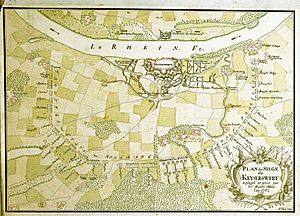Siege of Kaiserswerth facts for kids
Quick facts for kids Siege of Kaiserswerth (1702) |
|||||||
|---|---|---|---|---|---|---|---|
| Part of the War of the Spanish Succession | |||||||
 The Allied siege plan |
|||||||
|
|||||||
| Belligerents | |||||||
|
|
|||||||
| Commanders and leaders | |||||||
| Prince of Nassau-Usingen | Marquis de Blainville | ||||||
| Strength | |||||||
| 38,000 men 80 guns 59 mortars 6 howitzers 70 hand-mortars |
5,000 men 30 artillery pieces and mortars |
||||||
| Casualties and losses | |||||||
| 2,800–9,000 killed and wounded | 350 killed and wounded | ||||||
The siege of Kaiserswerth was a major battle that happened between April 18 and June 15, 1702. It was part of a much larger conflict known as the War of the Spanish Succession. During this siege, a large army of about 38,000 soldiers from Prussia and the Netherlands attacked a small French fort.
This powerful Allied army, led by Imperial Field Marshal Walrad, Prince of Nassau-Usingen, also had 215 artillery cannons and mortars. They successfully captured the French fortress located on the Lower Rhine river in Germany. The French had taken control of this fort easily the year before. For the Dutch, capturing this fort was even more important than trying to push further into the Spanish Netherlands, which was controlled by the French.
The Battle to Take the Fort
The attack on Kaiserswerth was quite difficult and took a long time. It also resulted in many soldiers getting hurt or killed. This was partly because a key Dutch expert in sieges, Menno van Coehoorn, was not there to help.
The German forces faced several problems. They did not have enough gunpowder or cannonballs. They also lacked proper siege cannons and skilled engineers. The Dutch had to provide these important supplies and experts to the Prussians.
The plan was to dig trenches closer to the fort, but the different armies moved at different speeds. The Dutch advanced their trenches too quickly for the Prussians. The French soldiers defending the fort fought back very hard. Bad weather also made things difficult.
Adding to the challenges, French troops led by Camille d'Hostun, duc de Tallard arrived on the other side of the Rhine river. All these issues forced the Dutch to delay their planned attacks on the fort many times throughout May. The digging of trenches began on April 18. The Dutch hoped to capture the outer defenses (called the counterscarp) within a week, but the main attack only happened on June 9.
The French commander of the fort, Jean-Jules-Armand Colbert, Marquis de Blainville, sent a message on June 10. He told Marshal Louis-François de Boufflers that the Allied attackers were cut down "like grass before the mower's scythe" on the open ground in front of the fort (called the glacis). The French engineer in charge of the fort's defenses was Louis Filley, who had worked with the famous fort-builder Vauban. Despite their strong defense, the French soldiers in the fort finally gave up on June 15.
What Happened After the Siege
Capturing Kaiserswerth was very costly for the Allied forces. On June 9 alone, about 2,800 Allied soldiers were killed or wounded. Of these, 2,101 were Dutch soldiers. Overall, it took the Allies two months to capture a place that the famous engineer Vauban had once called just a "hole." Some estimates suggest that the total Allied losses were as high as 9,000 soldiers.
After the French soldiers surrendered, they were allowed to march out of the fort freely. They left with full military honors, which meant they were treated with respect for their bravery.

